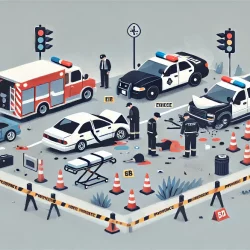Blunt Force Trauma: A Relationship with Car Crash Head Injuries
Car crashes are an unfortunate reality of modern life, and they can result in devastating injuries, especially head injuries caused by blunt force trauma.
The National Highway Traffic Safety Administration posits that “there will have been over 36,000 traffic fatalities in the United States in 2019, and a significant number of these were due to head injuries caused by blunt force trauma.”
This post delves into how car crashes cause blunt-force trauma, so read on and let us get to it!
What is Blunt Force Trauma?
Blunt force trauma refers to injuries caused by a sudden and direct impact on the body without penetration or laceration. In the case of a car crash, blunt force trauma can occur when the head strikes an object, such as the dashboard, steering wheel, or windshield.
A study by the National Institutes of Health found that over 70 percent of car crash victims who sustained head injuries had skull fractures, and more than 90 percent of these accidents were the effects of blunt force trauma.
Head Injuries Caused by Blunt Force Trauma
Head injuries caused by blunt force trauma can range from mild concussions or bruises to severe traumatic brain injuries (TBIs). Mild head injuries often result in headaches, dizziness, and confusion, while severe TBIs can lead to permanent brain damage or death.
In car crashes, the most common head injuries caused by blunt force trauma are skull fractures, contusions, and concussions. Skull fractures occur when the bones in the skull are broken and can lead to brain damage if bone fragments penetrate the brain tissue.
Contusions are bruises on the brain tissue, which can cause swelling and bleeding, and concussions leading to temporary loss of consciousness and memory loss.
Accident victims must seek immediate medical attention after they have hit their heads in an accident. Even if you feel fine, you may not be free from internal bleeding or torn tissues, which requires immediate medical attention. Lookout for symptoms like drowsiness, dizziness, ringing in the ears, slurred speech, and persistent headaches to identify blunt-force trauma cases.
Preventing Head Injuries Caused by Blunt Force Trauma in Car Crashes
The best way to prevent head injuries caused by blunt force trauma in car crashes is to wear a seatbelt and use a properly installed car seat for children. Seatbelts and car seats can reduce the risk of head injuries by preventing the head from striking hard surfaces in the car.
Another important safety feature is airbags. Airbags are designed and put in place to deploy during a crash to cushion the impact and prevent the head from striking hard surfaces. However, airbags can also cause injuries, especially if they deploy too forcefully or too close to the body. Therefore, it is important to sit at least 10 inches away from the airbag and to always wear a seatbelt.
Moreover, driving defensively and following traffic laws can reduce the risk of car crashes and head injuries caused by blunt force trauma. This includes driving safely, avoiding distractions such as texting or using a phone while driving, and obeying traffic signals and signs.
Conclusion
Car crashes can cause devastating injuries, especially head injuries caused by blunt force trauma. These injuries differ, leading to permanent brain damage or even death. Therefore, taking steps to prevent head injuries in car crashes is important.
Wear a seatbelt and use a properly installed car seat for children, sit at least 10 inches away from airbags, and learn to drive attentively. “By taking these steps, we can reduce the number of car crash fatalities and ensure that everyone on the road is safer.” says attorney Felix Gonzalez of Felix Gonzalez Accident and Injury Law Firm.
More to Read:
Previous Posts:




